UPSC GS 1
Kalleshwar Temple
- News: A 13th-century stone inscription, or Veeragallu, has been uncovered in Davanagere district during the renovation of the ancient Kalleshwar temple.
- Kalleshwar Temple:
-
- Kalleshwar Temple is located in Bagali, a town in the Davangere district of Karnataka.
- The temple is dedicated to Lord Shiva and is considered one of the oldest temples in the region.
- Its construction spans the rule of two prominent Kannada dynasties: the Rashtrakuta Dynasty in the mid-10th century and the Western Chalukya Empire during the reign of King Tailapa II around 987 AD.
- The temple is recognized as a monument of national importance by the Archaeological Survey of India.
-
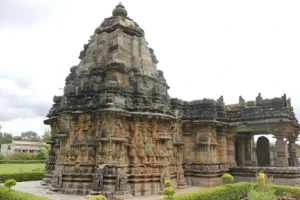
- Architectural Features:
-
- The temple is designed as a single-shrine structure with an adjoining hall (mantapa).
- It faces east and includes several interconnected sections:
- Sanctum (garbhagriha) where the main deity resides.
- Antechamber (antarala), which connects the sanctum to the gathering hall. This chamber features a sukhanasi, a small tower above it.
- Sabhamantapa, a hall used for gatherings and rituals.
- Mukhamantapa, the main entrance hall.
- The Shikara (temple tower) is a classic example of early Cholan architecture.
- The temple houses a large Shivalinga, believed to be more than 1,000 years old.
-
Read also: Rice Fortification in India | Scheme, Benefits, and Concerns | UPSC
Hurricane Milton
- News: Hurricane Milton has left Florida facing billions of dollars in damage and widespread power outages.
- About Hurricane Milton:
-
- The storm originated as a tropical depression within the Gulf of Mexico.
- On October 7, it escalated from a Category 1 hurricane to a severe Category 5 storm in just 12 hours.
- This rapid intensification was driven by abnormally warm sea surface temperatures, supplying the energy needed for the storm’s quick development.
- By October 8, Milton had reached peak wind speeds of 290 km/h (180 mph) and recorded a central pressure of 897 millibars, making it the third most powerful hurricane in Atlantic history.
- Following an eyewall replacement cycle, its wind speeds reduced to 240 km/h (150 mph), classifying it as a Category 4 hurricane.
- The National Hurricane Center (NHC) has issued warnings for storm surges, anticipating levels of up to 15 feet, particularly along Florida’s western coastline. Some areas are also expected to receive up to 460 mm of rainfall.
-
- About Hurricanes:
-
- Definition: Hurricanes, also known as tropical cyclones or typhoons depending on the region, are intense tropical storms characterized by sustained winds of at least 119 km/h (74 mph).
- Formation: These storms form over warm ocean waters near the equator, which act as the primary energy source.
- Development Process: As warm, moist air rises and cools, clouds form, releasing latent heat that powers the storm. This process continues, causing the system to grow and strengthen.
-
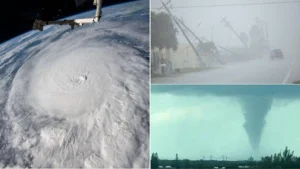
- Classification: Hurricanes are categorized according to the Saffir-Simpson Hurricane Wind Scale:
-
- Category 1: Winds between 119-153 km/h (74-95 mph).
- Category 2: Winds between 154-177 km/h (96-110 mph).
- Category 3: Winds between 178-208 km/h (111-129 mph), classified as a major hurricane.
- Category 4: Winds between 209-251 km/h (130-156 mph), with potential for catastrophic damage.
- Category 5: Winds above 252 km/h (157 mph), posing extreme danger and catastrophic consequences.
-
- Associated Hazards: Hurricanes bring a range of risks, including high winds, heavy rainfall, storm surges, and even tornadoes. Coastal regions are especially vulnerable, with flooding often being the most devastating effect.
- Influencing Factors: The behavior and movement of hurricanes are shaped by factors such as sea surface temperatures, atmospheric moisture levels, and wind shear.
Dr APJ Abdul Kalam
- News: PM Modi paid a heartfelt tribute to former President Dr APJ Abdul Kalam on his birth anniversary, calling his life an enduring source of inspiration for all Indians.
- Dr. APJ Abdul Kalam:
-
- Dr. Avul Pakir Jainulabdeen Abdul Kalam, popularly known as Dr. APJ Abdul Kalam, was an eminent Indian scientist, aerospace engineer, and visionary leader.
- He served as the 11th President of India from 2002 to 2007 and is fondly remembered as the “People’s President” for his exceptional contributions to science, technology, and India’s socio-economic development.
- Dr. Kalam was instrumental in advancing India’s ballistic missile and space technology programs.
-
- Birthplace and Family:
-
- Born on October 15, 1931, in Rameswaram, Tamil Nadu.
- His father, Jainulabudeen, was a boat owner, and his mother, Ashiamma, was a homemaker.
-
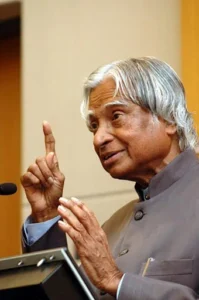
- Academic Journey:
-
- Completed a bachelor’s degree in physics in 1954 from Tiruchirappalli.
- Earned a degree in aeronautical engineering from the Madras Institute of Technology.
-
- Career Highlights:
-
- DRDO: Began his career at the Aeronautical Development Establishment under the Defence Research and Development Organisation (DRDO) in 1960.
- ISRO:
- Worked with renowned scientist Vikram Sarabhai as part of the INCOSPAR committee.
- Joined the Indian Space Research Organisation (ISRO) in 1969 and led the development of SLV-III, India’s first satellite launch vehicle.
-
- Missile Development Projects:
-
- Directed Project Devil and Project Valiant in the 1970s, aimed at creating ballistic missiles using the SLV technology.
- Spearheaded the development of the Agni and Prithvi missiles, which earned him the title “Missile Man of India.”
- Pokhran-II Nuclear Tests (1998): Played a key role in the successful nuclear tests, bolstering India’s defense capabilities.
- Principal Scientific Advisor: Served as the Principal Scientific Advisor to the Prime Minister from 1999 to 2001.
- Presidential Tenure (2002-2007):
- Elected as the 11th President of India and became the first scientist to hold the office without any political background.
-
- Contributions:
-
- Space Technology:
- SLV-III: Played a key role as Project Director in developing India’s first indigenous Satellite Launch Vehicle, which placed the Rohini satellite in orbit in 1980.
- PSLV Development: Contributed to the Polar Satellite Launch Vehicle (PSLV) program, advancing India’s space exploration capabilities.
- Missile Technology and Defense:
- IGMDP: Led the Integrated Guided Missile Development Program, which resulted in the creation of missiles like Agni and Prithvi, strengthening India’s defense capabilities.
- Pokhran-II: His leadership during the 1998 nuclear tests was crucial in establishing India’s status as a nuclear power.
-
- Healthcare Innovations:
-
- Kalam-Raju Stent: Collaborated with cardiologist Soma Raju to develop a low-cost coronary stent, reducing the price of stents by over 50%.
- Kalam-Raju Tablet: In 2012, they developed a rugged tablet computer to improve healthcare delivery in rural areas.
-
- Literature and Youth Empowerment:
-
- Books: Authored several inspirational books, including Wings of Fire, My Journey, Indomitable Spirit, Ignited Minds, and India 2020.
- Youth Empowerment: Advocated for the empowerment of young people and inspired them to pursue careers in science and technology.
-
- Social Initiatives:
-
- Social Justice: Worked towards improving the lives of marginalized communities.
- Technology Vision 2020: Led efforts to create a roadmap for India’s transformation from a developing to a developed nation.
-
- Awards and Honors:
-
- Von Braun Award – National Space Society
- Indira Gandhi Award for National Integration
- Veer Savarkar Award
- Padma Bhushan and Padma Vibhushan
- Bharat Ratna – India’s highest civilian award (1997)
-
- Special Honors:
-
- Received honorary doctorates from 30 universities and institutions.
- His birthday, October 15, is celebrated as “Youth Renaissance Day” in Tamil Nadu.
- NASA named a newly discovered bacterium found on the International Space Station Solibacillus kalamii in his honor.
- Wheeler Island, a missile testing site in Odisha, was renamed Abdul Kalam Island.
-
- Legacy:
-
- Dr. APJ Abdul Kalam’s visionary leadership in science, space, and technology continues to inspire generations.
- His dedication to empowering youth, commitment to social justice, and pursuit of scientific excellence have cemented his place as one of India’s most cherished leaders.
- Dr. Kalam passed away on July 27, 2015, while delivering a lecture at IIM-Shillong, leaving behind a legacy of innovation, inspiration, and service.
-
UPSC GS 2
Serious Fraud Investigation Office (SFIO)
- News: The Serious Fraud Investigation Office (SFIO) recorded the statement of T. Veena, daughter of Kerala Chief Minister Pinarayi Vijayan and owner of a now-dormant information technology firm.
- Overview:
-
- SFIO is a specialized agency established by the Government of India to investigate corporate fraud.
- It was granted statutory status under Section 211 of the Companies Act, 2013.
- The agency officially came into existence on July 21, 2015.
-
- Structure and Composition:
-
- SFIO operates under the Ministry of Corporate Affairs.
- It is a multi-disciplinary body comprising experts in fields like:
- Accountancy
- Forensic auditing
- Law
- Information technology
- Company law
- Capital markets
- Taxation
- These experts work together to detect and prosecute, or recommend prosecution of, white-collar crimes and fraud.
-
- Investigation Criteria: SFIO investigates cases with specific characteristics:
-
- Complexity: Cases involving interdepartmental or multidisciplinary challenges.
- Public Interest: Significant monetary impact or cases involving public interest.
- Systemic Impact: Investigations likely to improve systems, laws, or procedures.
- Referral Cases: Includes serious fraud cases referred by the Department of Company Affairs.
-
- Assignment of Cases: Cases are assigned to SFIO under the following circumstances:
-
- On receipt of a report from the Registrar or inspector under Section 208 of the Companies Act, 2013.
- Upon passing a special resolution by a company requiring investigation.
- In the public interest or at the request of a Central or State Government department.
- The SFIO can also initiate investigations independently, provided the decision is made by the Director with written justification.
-
- Exclusive Jurisdiction:
-
- Once a case is assigned to SFIO, no other investigative agency can pursue investigations for the same offence under the Companies Act.
-
- Leadership and Staff:
-
- The SFIO is headed by a Director at the rank of Joint Secretary to the Government of India.
- The Director is supported by Additional Directors, Joint Directors, Deputy Directors, Senior Assistant Directors, Assistant Directors, Prosecutors, and secretarial staff.
-
- Headquarters: Located in New Delhi.
- Regional Offices: Situated in Mumbai, Chennai, Hyderabad, and Kolkata.
UPSC GS 3
THAAD (Terminal High Altitude Area Defense)
- News: US will send THAAD defence battery system to Israel to help bolster its already impressive ability to counter incoming missiles following Iran’s attacks.
- THAAD (Terminal High Altitude Area Defense):
-
- It is a key component of the US military’s layered air defense system and complements Israel’s advanced missile defenses.
- It is designed to intercept ballistic missiles during their terminal (descent) phase, whether inside or outside the atmosphere.
-
- Components of a THAAD Battery:
-
- Personnel: Operated by approximately 95-100 troops.
- Launchers: Six truck-mounted launchers, each carrying eight interceptors (total 48 interceptors per battery).
- Radar System: Advanced radar surveillance using the AN/TPY-2 radar system.
- Fire Control System: Includes tactical fire components and communications infrastructure.
-
- Manufacturer Details: It has been developed by Lockheed Martin Corporation.
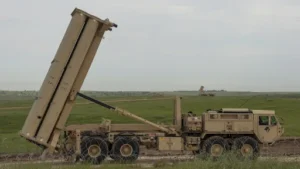
- Capabilities and Range:
-
- Missile Types Intercepted: It is s the only US missile defense system that can engage and destroy short-, medium-, and intermediate-range ballistic missiles both inside or outside the atmosphere during their terminal phase of flight – or dive on their target.
- Range: Capable of intercepting missiles at 150-200 kilometers (93-124 miles).
- Interceptor Type: Kinetic interceptors destroy targets by colliding with them, not by explosion.
- Technology: It employs “hit-to-kill” technology to destroy threat missiles and can defend a larger area than the older Patriot Air and Missile Defense System.
-
- Radar System (AN/TPY-2): The radar system of THAAD supplies its targeting information, the Army Navy/Transportable Radar Surveillance radar, or AN/TPY-2.
-
- The radar system, which can be deployed with the missile battery or already be in place on US Navy ships can detect missiles in two ways:
- In its forward-based mode it is configured to acquire and track targets at ranges of up to 3,000 kilometers (1,865 miles).
- In its terminal mode, it is aimed upward to acquire targets during their descent.
-
- Modes of Operation:
-
- Forward-Based Mode: Detects and tracks targets at ranges up to 3,000 kilometers (1,865 miles).
- Terminal Mode: Tracks descending missiles to intercept them.
-
- Strategic Relevance:
-
- Accurate Targeting: The AN/TPY-2 radar is essential for THAAD’s precision and ensures reliable interception.
- Regional Significance: THAAD’s range covers threats such as Iran, which lies about 1,700 kilometers (1,100 miles) from Israel.
-
Aortic Aneurysm
- News: Actor Rajinikanth was treated for an aortic aneurysm recently, at a private hospital in Chennai.
- Definition:
-
- The aorta is a vital blood vessel that carries oxygen-rich blood from the heart to the rest of the body.
- It starts from the left ventricle, moves upwards, curves down, and travels through the chest and abdominal cavities, ending at the pelvis.
- An aneurysm is a swelling or bulge in a blood vessel caused by a weakened wall.
-
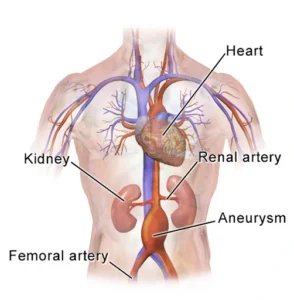
- Abdominal Aortic Aneurysm (AAA):
-
- Occurs in the abdominal section of the aorta.
- The walls of the aorta, typically strong enough to handle blood pressure, can weaken due to certain conditions.
- When weakened, the aorta may widen or balloon, increasing the risk of rupture or tearing.
-
- Causes of Aortic Wall Damage: High blood pressure, smoking, atherosclerosis, injury, some infections, such as untreated syphilis, some genetic conditions, such as Marfan syndrome and aging.
- Treatment: Abdominal aortic aneurysms can be treated through endovascular repair, a minimally invasive procedure.
X-band Radar
- News: After devastating floods and landslides killed more than 200 people in Kerala’s Wayanad district in July 2024, the Union Ministry of Earth Sciences approved an X-band radar to be installed in the district.
- X-band Radar Overview:
-
- An X-band radar operates in the X-band range of the electromagnetic spectrum, emitting radiation at 8-12 GHz, with wavelengths between 2-4 cm.
- Shorter wavelengths enable the radar to produce high-resolution images.
- However, higher frequency radiation experiences faster attenuation (reduction in strength over distance).
-

- Applications of X-band Radar:
-
- Landslide Monitoring: Can track the movement of particles such as soil and issue landslide warnings.
- High Temporal Sampling: Capable of rapid sampling to detect particle movements occurring in short time spans.
- Meteorological Studies: Frequently used for monitoring cloud development and detecting light precipitation. Effective at identifying tiny water particles and snow due to its ability to sense small particles.
-
- What is Radar?
-
- RADAR stands for Radio Detection and Ranging.
- It uses radio waves to determine the distance, speed, and characteristics of surrounding objects.
-
- How it works:
-
- The radar transmitter emits a signal aimed at an object.
- The object reflects a portion of the signal back to the radar.
- The receiver captures the reflected signal to analyze the object’s properties (e.g., in meteorology, it could be a cloud).
-
- Doppler Radar:
-
- Weather radar is often a Doppler radar, which measures movement based on the Doppler effect.
- The Doppler effect refers to the change in the frequency of waves as their source moves towards or away from the observer.
-
- In meteorology:
-
- Doppler radars track how the cloud’s movement alters the frequency of the radiation it reflects.
- They can determine the speed and direction of clouds.
-
- Pulse-Doppler Radar:
-
- A pulse-Doppler radar emits radiation in pulses and measures how often they are reflected back.
- It can gauge the intensity of rainfall by analyzing the frequency of reflected pulses.
- Modern Doppler radars are used to monitor weather conditions and predict new wind patterns or storms.
-
Tenkana Jayamangali
- News: A new species of spider, Tenkana Jayamangali, has been found in the forests of Devarayanadurga, Tumakuru.
- New Spider Species:
-
- A newly discovered spider species, named Tenkana jayamangali, has been identified in the Devarayanadurga Reserve Forest, Karnataka.
-
- Naming Origin: It is named after the nearby Jayamangali River.
- Taxonomic Relations: The species is closely related to T. arkavathi and T. manu.
- Taxonomy: Tenkana jayamangali is part of a newly established genus of jumping spiders—Tenkana—belonging to the family Salticidae (Plexippina group) from South Asia.

- Distribution: Found in southern Indian staztes, including Andhra Pradesh, Karnataka, Kerala, Tamil Nadu, and Telangana, along with northern regions of Sri Lanka.
- Habitat Preference:
-
- Primarily ground-dwelling spiders.
- Found in diverse microhabitats, such as shaded areas with short grasses and dry leaf litter in groves.
- They also inhabit open, sunny regions with sparse grasses, especially near rocky outcrops in drier environments.
-
Read also: 11 Classical Languages of India – Complete UPSC Guide
Nagarjunsagar-Srisailam Tiger Reserve (NSTR)
- News: The recently released ‘EnviStats India-2024’ report ranks the Nagarjuna Sagar-Srisailam Tiger Reserve (NSTR) first among India’s 55 tiger reserves in terms of leopard population, with an estimated 360 leopards.
- Location:
-
- Situated in the Nallamala hill ranges, a branch of the Eastern Ghats, in Andhra Pradesh.
- It is the largest tiger reserve in India, covering an area of 5,937 sq. km.
- Known for hosting the largest tiger population within the Eastern Ghats.
-
- Naming: The reserve is named after the Nagarjuna Sagar and Srisailam dams located in the region.
- Constituent Sanctuaries: Comprises two wildlife sanctuaries: Rajiv Gandhi Wildlife Sanctuary and Gundla Brahmeswaram Wildlife Sanctuary (GBM).
- River Krishna: The river Krishna flows through the reserve for approximately 270 km.
- Topography: Features include plateaus, ridges, deep valleys, and gorges.
- Vegetation: Dominated by tropical dry deciduous forests with bamboo and grass forming the undergrowth.
- Flora: Hosts several endemic plant species, including:
-
- Andrographis nallamalayana
- Eriolaena lushingtonii
- Crotalaria madurensis (Variety)
- Dicliptera beddomei
- Premna hamiltonii
-
- Fauna:
-
- Carnivores: Includes Tigers, Leopards, Wolves, Wild Dogs, and Jackals.
- Prey Species: Comprises Sambar, Chital, Chowsingha, Chinkara, Mouse Deer, Wild Boar, and Porcupines.
- Aquatic Life: The Krishna River supports species like Muggers, Otters, and Turtles.
-
Predator Drones
- News: India and the US are finalizing deals valued at ₹34,500 crore to enhance the Indian armed forces’ surveillance capabilities, which includes an agreement for the acquisition of 31 Predator drones and the establishment of a maintenance, repair, and overhaul (MRO) facility in India.
- What are Predator Drones?
-
- The MQ-9B, also known as the Predator B drone, is an advanced unmanned aerial vehicle (UAV) developed by General Atomics.
- It supports both remotely piloted and autonomous flight operations.
-
- India’s Acquisition:
-
- The United States approved the sale of 31 MQ-9B drones to India in February at an estimated cost of $3.99 billion.
-
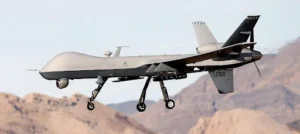
- Key Features:
-
- Stealth Capability:
- The MQ-9B Predator boasts whisper-quiet operation, enhancing its stealth.
- It can operate as close as 250 metres from the ground without being detected unless visually spotted.
- Altitude and Speed:
- The drone flies at a maximum speed of 442 km/h.
- It can reach an altitude of around 50,000 feet, higher than typical commercial airplanes.
- All-Weather Missions:
- The MQ-9B is designed for extended missions in all weather conditions, making it highly versatile.
- Payload and Armament:
- It can carry up to 1,700 kg of cargo, including:
- Four missiles and approximately 450 kg of bombs.
- It is capable of being equipped with air-to-ground and air-to-air missiles.
- Range and Endurance:
- The drone can cover 2,000 miles (3,218 km) without refueling.
- It can fly continuously or hover over targets for up to 35 hours, according to the manufacturer, General Atomics Aeronautical Systems.
-

